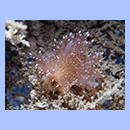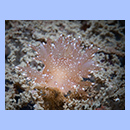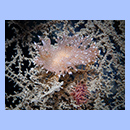- Kingdom: Animalia
- Phylum: Mollusca
- Class: Gastropoda
- Subclass: Heterobranchia
- Order: Nudibranchia
- Suborder: Dexiarchia
- Infraorder: Dendronotida
- Superfamily: Tritonioidea
- Family: Dendronotidae
- Scientific name: Dendronotus robustus
- Norwegian: -
Characteristics:
This species appears, as the name indicates, as a rather robust species. The body is not as slender as the other Norwegian members of the Dendronotus family. It can reach a length of 15 centimeters. The color is usually reddish brown. A typical characteristic for all the Dendronotus species is the bushy appearance of the gills on the back of the body. It can be difficult to distinguish D. robustus from the some of the other Dendronotus species known, from Norwegian waters:
- D. frondosus has between 6 and 12 lamellae on the rhinophores (organ on the top of the head, used to "smell" chemical compounds in the water). The gills are moderately branched, they usually have secondary, but sometimes even tertiary branches. The secondary and tertiary branches have rounded tips. Many specimens have pigmented spots or stripes, but entirely white white, translucent bodies are fairly common, as well.
- D. lacteus has between 10 and 14 lamellae on the rhinophores. The gills tends to be more heavily branched. The tertiary branches are short. The tip of the secondary branches are shaped like spikes, in contrast to the rounded branches of D. frondosus. The color variation is as great as the D. frondosus, but white specimens seems to be common in Trøndelag waters. This is also reported from Sweden, by Thollesson. D. robustus has shorter, not so heavily branched gills, compared to the two species above. The flattened, not so slender body gives this species a more robust appearance. It is often heavily pigmented, making the body look reddish brown. White pigmented spots are scattered out over the entire body and tentacles. Close-ups will reveal fine wrinkles in the skin.
- D. yrjargul has the same color scheme as the Dendronotus sp. I found in 2005. The tip of the cerata are heavily fringed and brown pigmentations runs as two lines on the back of the white, translucent body. The rhinophores have 18-30 lamellae. Body lengths up to 10 cm have been observed.
Habitat:
It seems to thrive on muddy locations. It has been observed from the intertidal zone and as deep as 230 meters.
Distribution:
This is an Arctic species, known in the North Atlantic Ocean as far south as Norway and the British Isles.


